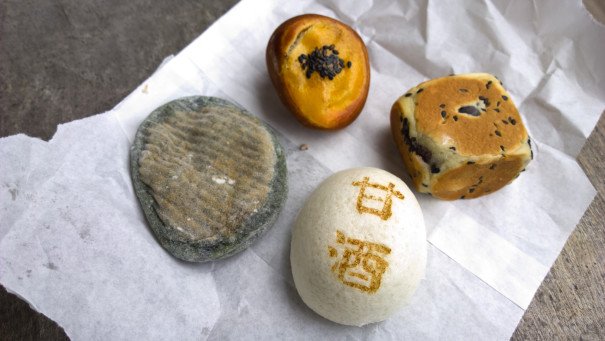
Visiting a Place of Death That Teems With Life

Visiting a Place of Death That Teems With Life
Sweets in Kōya-san
Starting in Osaka, the train shoots south, crosses rice paddies, decelerates, and slowly winds through mountains blanketed by cedars and hydrangeas. Hardcore hikers hop off at periodic stops to conquer the countryside for a few hours on a weekend morning. They stride with pride and purpose as the rest of us pull away. A mother leading her son’s Cub Scout troop tells the kids to peek out the window, and mentions something about adventure. Indeed, it is. At the terminus, one of the steepest cable car rides in Japan takes us higher. Reaching Mount Kōya takes time, or effort, or both.
In the early 800s, Kūkai, a monk and the son of a wealthy Japanese family, boarded a boat and sailed west. His goal was to learn a more colorful strain of Buddhism than what was practiced by his peers. Tang Dynasty China possessed the answers he sought, so he traveled there, soaked up local culture, found a master, studied hard, wrote a lot of poetry, honed his calligraphy skills, and then went home.
Kūkai didn’t return to Japan empty-handed. He brought with him scriptures, artifacts, relics, treasures, and most importantly, knowledge. It took a few years for Kūkai’s “new” version of Buddhism to take off, but once it did, he left an imprint on Japanese culture that is still felt today. Kyoto was his headquarters, but his remains are now in Kōya-san, 90 miles away, in the center of a mandala that covers all of Japan.
I pick up a few snacks to fuel my journey: yakimochi, amazake-manjyu, the like. They’re common sweet treats that could be found anywhere in Japan. On the roads that connect 120 temples, cyclists clad in neon tights zip by as pilgrims in white robes and conical straw hats find their own way. A dozen or so motorcycles rumble over, as foreigners on meditation retreats sit unperturbed on tatami mats. Later on, they will be served a lunch of tofu prepared in many ways.
The legends say Kūkai himself greets those who cross the bridge leading to his mausoleum. People stop to bring their hands together and bow before entering the graveyard that surrounds the grand master’s final resting place. Feudal warlords and samurai warriors lie there. A sandstone grave marker broadcasts cries from hell if you listen hard enough. One statue is permanently moist, sweating as it experiences the pain and suffering of humanity. Everything is covered in moss, everything breathes. Birds cry in the mist. This place of death teems with life.
Past the graves, past the trees, past the contemplation lies Kūkai’s mausoleum. Devotees plant lit incense, say a prayer, then use their palms to push the smoke onto their scalps, their arms, their skin until it clings. Ten thousand lanterns are kept eternally lit.
If Japan’s urban experience has been engineered to perfection, then places like Kōya must have been sculpted by something else, something supernatural, guiding the hands of Kūkai and his successors. Even the faithless lose themselves in rolling hills and whispered prayers as they search for mystery in hushes of cedar groves and the pale blue glow of hydrangeas.